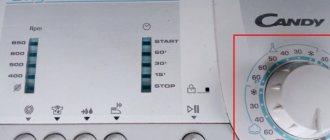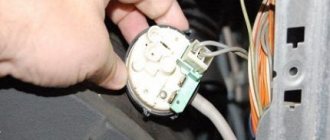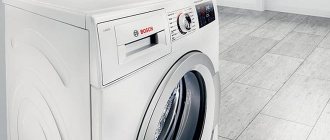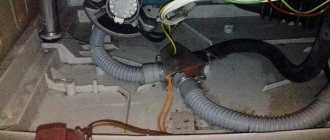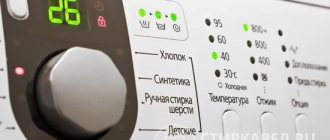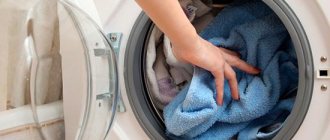Error codes for Siemens washing machines
Modern technology itself informs the owner about the presence of certain malfunctions.
True, she does this not in ordinary human language, but using special character codes on the device’s display. You can easily determine what each of them means from our list. Error F23.
The Aquastop system was activated, signaling the presence of a leak in the machine parts. Until the error is corrected, using the device is strictly prohibited. It is necessary to check the pan in the center of which, as a rule, water begins to accumulate. The main causes of leakage may be damage to the hose or drain pump, or a crack in the tank. After eliminating the malfunction, the error goes away, and the Aquastop system is switched back to monitoring mode.
Error E18.
There is a malfunction in the drainage system. The drain filter may become clogged, a problem may arise in the drainage channels, or some small part may simply fail. If this error occurs, you should immediately stop the water supply and unplug the device from the electrical network. First you need to remove and clean the drain filter, then check if the drain pump is clogged, then return all the parts to their place and try to turn on the machine. If the error remains, the problem is in the control module.
Error E23.
Like error f23, it indicates the presence of leaks. Also, the occurrence of this error may indicate a malfunction of the aquastop system itself - damaged contacts, for example. The repair procedure here is the same as for error f23 - it is necessary to identify and eliminate the reason for the operation of the machine’s protective system.
Error F18.
Problems with draining water. It also warns the owner that the device cannot properly drain the waste fluid. The reason most often lies in blockages; in more serious cases, the control unit is to blame.
Error F18.
Tells us about a breakdown in the drive motor control system. It is necessary to diagnose the engine control relay and replace failed parts.
Error E17.
It usually occurs due to a lack of water at the inlet valve. It is necessary to check the functionality of the solenoid valve by measuring the resistance of the coil.
Error F04.
And again the machine tells us about a leak. The procedure here is the same as for similar errors - we find the leak and fix it.
Typical faults
Let's look at the breakdowns that most often occur, as well as the possibilities of repairing Siemens washing machines with your own hands.
Drain tract clogged, pump malfunction in a Siemens machine
Poor drainage of water after washing or its complete absence indicates a blockage in the drain pipe or filter, or a breakdown of the pump - in 30% of cases.
The pump in a Siemens washing machine is located behind the front panel. Therefore, to get to it, you will have to work hard:
- Unplug the washing machine and turn off the water supply.
- There is a drain hatch at the bottom of the front panel.
- Open it, insert the container and pull out the filter.
- Clear it of any blockage.
- Remove the top panel by removing the screws at the back.
- Remove the dispenser tray.
- Remove the metal clamp securing the cuff.
- Disconnect the UBL wiring.
- Unscrew the front panel mounting bolts.
- Removing the panel, you will see the pump below.
Check the pipe and pump for blockages. To clean, simply remove the pipe and rinse under running water.
To remove the pump, disconnect the connectors and unscrew the fixing bolts.
Problems with the Siemens CM inlet valve
If you notice that the washer does not fill or overflows water, the intake valve is probably broken. You can repair and replace the valve in a Siemens washing machine yourself:
- Disconnect the intake hose from the SMA.
- Remove the rear screws and remove the top panel.
- Disconnect the valve coil connector wires.
- Remove the hoses leading to the valve.
- At the back of the housing, unscrew the two bolts that secure the valve. Get it out of the car.
You can install the new element in reverse order.
No water heating, heating element failure in Siemens car
Heating element malfunctions account for 15% of all Siemens machine breakdowns. The reason for this is scale or short circuit. Scale prevents the heater from releasing heat, causing it to overheat and burn out.
Having reached the heating element in the Siemens washing machine, check it with a multimeter before replacing it.
To remove the heating element, remove the front panel of the SM, as described above. Attach the multimeter probes to its contacts and compare the readings with the photo.
If there is a malfunction, replace it yourself:
- Disconnect all wires.
- Loosen the central nut and push the bolt inward.
- Prying up the edges, remove the element.
- Install the working heating element in reverse order.
Water leak in Siemens machine
Water leakage problems account for 10% of all breakdowns.
Leakage occurs due to depressurization of seams or damage to parts and connections. The hatch cuff may also be damaged or worn.
We'll tell you how to replace the cuff on a Siemens washing machine with your own hands:
- Open the hatch door.
- Having bent the rubber cuff, pry off the metal clamp with a screwdriver.
- Carefully remove the clamp, then remove the front body of the machine.
- Disconnect the pipe leading to the cuff.
- Remove the cuff.
Inspect the cuff at the time of damage: can it be repaired or repaired? If not, then a new part is installed.
How to troubleshoot Siemens washing machines?
Very often, owners of Siemens washing machines are faced with the appearance of one or another error on the device display. The question arises - how to reset the error? Each type of malfunction has its own procedure. After all, it is not enough to simply reset the numbers on the display; it is necessary to eliminate the very cause of the breakdown in order to restore the full functionality of the washing machine.
Be careful:
If a malfunction occurs, be sure to read the instructions. Most problems can be caused by simple ignorance of the device's functions. Before using the washing machine, check the tightness of all hoses and tubes. And only after that proceed to its direct operation. Ignoring the instructions for use can cause serious damage, as well as complete failure of the machine.
Inlet valve
The inlet valve often causes problems with water supply. It is he who is responsible for starting and stopping the flood, receiving the appropriate command from the control board. If the device fails, then the washing machine does not fill within the specified time and displays fault code E17. To check the functionality of the device, you need to test it in several stages.
First of all, we inspect the valve for external damage. We remove the top cover from the housing and look for the device - it is located at the junction with the inlet hose and has several connected pipes. Then we evaluate its condition: are there any leaks, signs of fire, cracks or other defects. If visually everything is in order, we proceed to dismantling:
- Unclench the fixing clamps and release the connected pipes;
- take photographs of the valve terminals to facilitate reconnection of the wiring;
- remove the supply wires from the valve;
- unscrew the holding bolts;
- dismantle the device;
- Check to see if there are any blockages in the pipes.
It is better to carry out further diagnostics in the bathroom. We attach the inlet hose to the fitting and turn on the water supply. A properly functioning valve will hold back the flow of water and prevent leakage. If the device is leaking, then repair will not help - only replacement.
The next step will require vigilance and caution. The valve connected to the water supply must be supplied with a voltage of 220 Volts. If all is well, the coil will close, the membrane will work, and water will flow. But be careful - do not allow moisture to get on the wire contacts.
The valve of the washing machine cannot be repaired - if it breaks, it is replaced with a new one.
The final stage of testing is calling with a multimeter. We switch the tester to ohmmeter mode and alternately touch the probes to the winding of the solenoid valve. Normally, the resistance should be about 3 kOhm; if the device shows less, then a breakdown has occurred. You cannot repair the device with your own hands; all you have to do is replace it with a working one. The new valve is installed like this:
- insert the coil into the seat;
- fix the device with bolts;
- Based on the photo taken earlier, we connect the wiring and pipes;
- We return the top cover to the body.
All that remains is to plug Siemens into the network and run a test wash. If it is not possible to reset the error, then we continue the diagnostics.
What to do if the Siemens washing machine does not spin?
To ensure that the laundry is not wet when removed from the washing machine, a spin function is provided. But what should you do if the machine suddenly, for some reason, stops spinning clothes?
You must first check whether the spin program is set; as a rule, during gentle washing, machines do not spin the laundry. If this is not the problem, you should turn to troubleshooting.
1. Check whether the water drains normally after rinsing. (In the event of a drain malfunction, it is necessary to remove the hose and drain filter and rinse them thoroughly, and, if possible, clean the adjacent elements)
2. Is the drum rotation speed sufficient? (Here it is necessary to check the motor - remove the drive belt, disconnect the terminal with the power supply wires and the ground wire, unscrew the fastening screws and pull the engine off the skids. We check whether the graphite brushes are worn out and if they do not fit tightly to the engine commutator, replace them.)
3. Are there any electronic error codes on the display? (If an error code appears, look through the list above in the text and follow the described procedure).
Tips and prevention of breakdowns
- If you want to wash the outside of the machine, be sure to unplug the device, do not direct a stream of water at the equipment, and do not use household chemicals with solvents or abrasive particles. It is best to simply wipe the machine with a damp soft cloth.
- To remove scale from machine elements, you should use only products specifically designed for this purpose, taking into account their recommended dosages.
- Regularly inspect the cuvette into which detergents are loaded. If you see dirt or powder residue in it, remove the cuvette, rinse and return it.
- Check the condition of the sump pump several times a year. To do this, remove the base panel, remove the drain hose and drain the water, then clean the pump and check the rotation of its impeller. After closing the pump with the lid, secure the base panel.
- At least once a year, you should remove and inspect the strainer located in the water supply hose to the device.
The preventive measures shown in the Ukrainian program “Everything Will Be Good” will help increase the service life of your washing machine.
What to do if the Siemens washing machine does not turn on?
In a situation where the Siemens washing machine does not show any signs of life and does not respond to button presses, you should check the serviceability of the power cord. Disconnect the cord and measure the incoming voltage from the outlet.
The cause may also be a malfunction of the power button. In this case, it must be tested with a multimeter in the on and off state. When the machine is plugged in, you will hear a characteristic sound indicating that the button is OK.
The interference filter that protects the machine from power surges may also break. It is checked with the same device.
If the above checks do not produce results, most likely the control module has failed. It should be replaced.
Meaning of the specified code
The Siemens machine fault codes provided by the system are standard for all manufactured models, which simplifies their decoding. Let us repeat that E18 signals a problem in the drain system. We are talking about the following “sore points”:
Often the causes of failure are broken small parts, loose contacts or loose fixation of individual elements. All these are the consequences of improper operation of the machine with coins forgotten in pockets, torn buttons, wool and hair stuck to clothes. From the drum, foreign objects enter the tank, filter and hoses, impeding the circulation of water and the rotation of the pump impeller.
Most of the listed sources of error E18 can be replaced, adjusted and repaired without the involvement of service personnel. If you want to deal with the problem without outsiders, we start diagnosing it ourselves.
Functions of Siemens washing machines
Siemens machines offer a wide range of different functions, the range of which will satisfy the needs of any family.
Spin.
Thanks to this function, the laundry is removed from the machine half dry.
Water level control.
The machine itself determines how much water is needed for a given program and the volume of things. This saves money when underloading.
Drain.
Forced water discharge, without spinning.
Half load.
If there is not too much laundry, use this function to reduce the consumption of water and washing powder.
Delayed activation.
In some cities it is cheaper to do laundry at night; you can set a timer and the machine will turn on itself at the appointed time.
Child protection.
Your children will not be able to open the machine or make any changes to the wash program.
Reloading laundry.
If during the washing process you find dirty things in the apartment, you can simply add them to the machine by pressing the pause button.
Errors E17, F17 in Siemens without display
Models not equipped with an LCD screen indicate a problem using warning lights.
- Siemens IQ series . In machines of this line, with error E17, the upper spin speed indicator (1000 or 1200) and the lowest indicator, indicating the “no spin” program, blink.
- Siemens Siwamat series. In the SMA of this model range, when error E17 occurs, the middle LED in the vertical row of indicators blinks (as a rule, this is the “work” indicator).
Elimination
Actions must be taken based on the malfunction. For example, if fault F04 is displayed, then you need to find and fix the leak. If you need to unlock the control panel to solve the problem, you can restart the washing machine.
It is important to first turn off the power using the button, then unplug the power cord from the outlet.
Troubleshooting common errors:
It is highly not recommended to fix critical errors yourself. Incompetent repairs can lead to the equipment becoming completely inoperable.
You should immediately contact the service center and call a technician. You can only deal with typical, minor breakdowns on your own.
Let's check the pressure switch
The display of error F17 may occur due to a faulty pressure switch. The level sensor measures the volume of water in the tank; if it does not function correctly, an incorrect signal is transmitted to the control module, and the “brain” blocks the operation of the SMA. To diagnose the pressure switch, you need:
A working level sensor will produce one or three characteristic clicks. If the device does not make any sounds, it can be stated that it is broken.
Inspect the pressure switch for defects and mechanical damage. Make sure its hose is not clogged. If you find contaminants in the cavity, be sure to rinse the hose under the pressure of warm water.
If a visual inspection does not allow you to clearly understand that the pressure switch is faulty, you can check the sensor with a multimeter. The device is put into resistance determination mode, its probes are applied to the contacts of the pressure switch relay. The values on the multimeter display will change when the contacts are triggered. If the readings remain initial, the level sensor does not work. To understand which contacts of the pressure switch you need to connect the multimeter to, first study the electrical diagram of the device.

